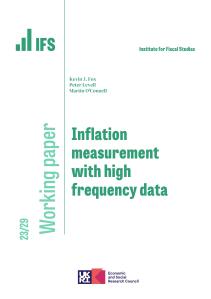Last week’s Spring Statement was characterised as much by what Rishi Sunak didn’t say as by what he did. Perhaps most obviously, he announced no additional support for poorer households reliant on benefits, beyond a small pot of money for councils in England to dispense at their discretion. It remains to be seen whether another round of support measures will be required later in the year as prices continue to rise.
But it isn’t just households that will be squeezed by soaring inflation. Public services are also exposed, for the simple reason that their budgets are fixed in cash terms. Higher inflation means that the same cash budgets will buy less. On this, too, the Chancellor was silent; he made no mention of public services in his speech and left his cash spending plans unchanged. That amounts to a real-terms cut in the generosity of those budgets, relative to what was previously planned.
There’s no doubting that public services will face additional cost pressures: hospitals, schools, care homes and prisons will need to pay more to heat their buildings; the Ministry of Defence will need to pay more to refuel its vehicles; and pay awards for public sector workers are almost certain to be more generous than was forecast back in the autumn, when plans were agreed. But it’s difficult to assess precisely how much less generous the Chancellor’s plans have become.
In making such assessments, we typically use a measure of inflation called the GDP deflator. On the basis of the Office for Budget Responsibility’s latest forecasts for this measure of inflation, the average real-terms growth rate in departments’ day-to-day budgets has dropped from 3.3% to 2.9% (i.e. higher inflation has wiped out around one-eighth of the planned real-terms increases). However, for a couple of fiendishly complicated technical reasons, the GDP deflator probably understates the cost pressures facing public services over the next year or two. If we instead use the Consumer Price Index (CPI, a measure of the inflation rate facing households), the average growth rate would drop from 3.3% to 1.7%, and higher inflation would appear to have wiped out almost half of the planned real increases. The ‘true’ value probably lies somewhere between these two figures.
Given the uncertainty over the scale of the cost pressures facing departments, and the fact that the 2022-23 financial year hasn’t even started yet, the Chancellor was probably right not to announce any immediate adjustments to his spending plans. The most appropriate time for any such adjustments would be the autumn Budget: halfway through the financial year, when public sector pay awards have been agreed and the outlook for inflation has hopefully become clearer. Compensating departments for higher than expected inflation might require something in the region of £5 billion to £10 billion in 2022-23, with more in later years.
The Chancellor has signalled, however, that a top-up to his spending plans is not at the top of his list of priorities. He promised “to be disciplined, with the first call on any extra resources being lower taxes, not higher spending”. Notably, some of his Cabinet colleagues have reportedly urged him to go further and cut his cash spending plans in order to fund more support for households. Pre-election tax cuts seem to be the order of the day.
What does this mean? It means that along with households, public services will almost certainly be asked to bear some of the pain of the continued bad economic news. For some departments, that could mean real-terms cuts. At the least, it means some of the real-terms budget increases public services were previously expecting will be eroded, and makes below-inflation pay awards for public sector workers a near certainty. And it means more difficult choices for the Chancellor.









